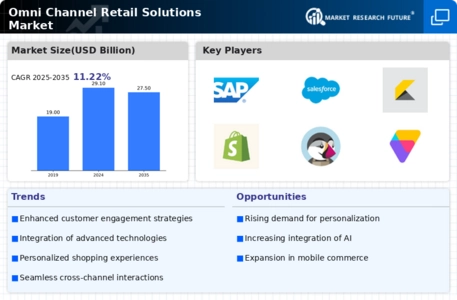The Omni Channel Retail Solutions Market is currently characterized by a dynamic competitive landscape, driven by the increasing demand for seamless customer experiences across various channels. Key players such as Salesforce (US), SAP (DE), and Shopify (CA) are strategically positioning themselves through innovation and partnerships to enhance their service offerings. Salesforce (US) focuses on integrating advanced analytics and AI capabilities into its platform, thereby enabling retailers to personalize customer interactions more effectively. Meanwhile, SAP (DE) emphasizes its cloud-based solutions, which facilitate real-time inventory management and customer engagement, thus enhancing operational efficiency. Shopify (CA) continues to expand its ecosystem by integrating third-party applications, allowing merchants to customize their online and offline sales strategies, which collectively shapes a competitive environment that prioritizes customer-centric solutions.
The business tactics employed by these companies reflect a trend towards localization and supply chain optimization. The market appears moderately fragmented, with numerous players vying for market share, yet the influence of major companies is substantial. Their collective efforts in enhancing technological capabilities and streamlining operations contribute to a more cohesive market structure, where agility and responsiveness to consumer needs are paramount.
In August 2025, Salesforce (US) announced a strategic partnership with a leading logistics provider to enhance its fulfillment capabilities. This move is significant as it allows Salesforce to offer integrated solutions that streamline the supply chain for retailers, thereby improving delivery times and customer satisfaction. Such partnerships are indicative of a broader trend where technology firms are increasingly collaborating with logistics companies to create comprehensive omni-channel solutions.
In September 2025, SAP (DE) launched a new suite of tools aimed at improving customer engagement through enhanced data analytics. This initiative is crucial as it enables retailers to leverage customer insights for more targeted marketing strategies, thereby driving sales and fostering brand loyalty. The focus on data-driven decision-making reflects a growing recognition of the importance of analytics in the retail sector.
In October 2025, Shopify (CA) unveiled a new feature that allows merchants to integrate augmented reality (AR) into their online stores. This innovation is likely to enhance the shopping experience by providing customers with immersive product interactions, potentially increasing conversion rates. The introduction of AR technology signifies a shift towards more interactive and engaging retail experiences, aligning with current consumer expectations.
As of October 2025, the competitive trends within the Omni Channel Retail Solutions Market are increasingly defined by digitalization, sustainability, and the integration of AI technologies. Strategic alliances are becoming more prevalent, as companies recognize the need to collaborate to enhance their service offerings. Looking ahead, competitive differentiation is expected to evolve, with a notable shift from price-based competition to a focus on innovation, technological advancements, and supply chain reliability. This transition underscores the necessity for companies to adapt and innovate continuously in order to maintain a competitive edge.

















Leave a Comment